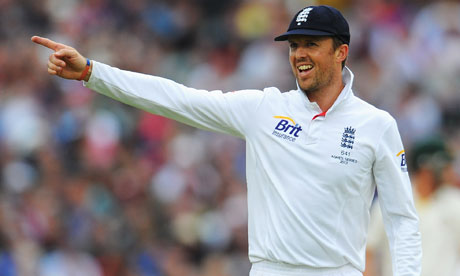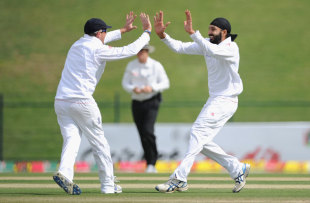Ashley Mallett in Cricinfo
Shane Warne's
star illuminated the cricket firmament, inspiring generations with the
majesty of his art. When Warne reigned supreme on the Test stage, you'd
see kids in the park and in the nets trying to emulate him. They got
the saunter right, but what they didn't see was Warne's amazing
strength, drive and energy through the crease. Watching him, it all
looked so easy. They would emulate his approach, release the ball, and
more times than not watch it disappear out of the park. There was a
general lack of understanding about energy and drive through the crease.
Warne turned up just when we all thought legspin had gone the way of the
dinosaurs, who were bounced out when Earth failed to duck a hail of
meteors. Sir Donald Bradman said Warne's legspin was the best thing to
happen to Australian cricket in more than 30 years. I, along with
thousands of television viewers, watched transfixed as Warne weaved his
magic. Poor Mike Gatting, poor, hapless Daryll Cullinan.
I was in the South African dressing room when Warne destroyed them with 6 for 34 in their second innings
at the SCG in 1998. And we all remember the time he got seven wickets for 50-odd
at the MCG
against West Indies, getting Richie Richardson with a flipper. Before
that grand performance, which sparked his career, the camera focused on
Warne in the field, and Bill Lawry said on air: "Now there's a young man
who won't get much bowling today." The Phantom was right: Warne bowled
23 overs; not a lot of work for a slow bowler, but that was all he had
to get seven wickets.
Warne's genius got him 708 wickets in 145 Tests. His physical skills
were matched by an incredibly strong mind. He was frequently in a lot of
controversy off the cricket field, but he managed to focus totally on
his cricket when it mattered on the field of play. As with Don Bradman
and Garry Sobers, he was a cricketing phenomenon.
The Indian offspinner
Erapalli Prasanna
was a small, rotund chap, with little hands and stubby fingers. Not the
size of hand you'd think would be able to give a cricket ball
tremendous purchase.
Pras, as he was affectionately called, bounced up to the wicket and got
very side-on. He was short, so he tended to toss the ball up, and he
spun it so hard it hummed. Unlike the majority of spinners, he could
entice you forward with tantalising flight or force you back, and often
got a batsman trapped on the crease. His changes of pace weren't always
as subtle as Warne's, but Pras broke the rhythm of batsmen better than
any spinner I've seen - especially with that quicker ball, which
perplexed the best players of spin bowling in his era.
He possessed a mesmerising quality in that he seemed to have the ball on
a string. You'd play forward and find yourself way short of where you
expected the ball to pitch. In Madras once, I thought I'd take him on
and advanced down the wicket only, to my horror, find that Pras had
pulled hard on the "string" and I was miles short of where the ball
pitched. I turned, expecting to see Farokh Engineer remove the bails,
only to see the ball, having hit a pothole, climb over the keeper's head
for four byes.
Pras was one of the few spinners to worry the life out of Ian Chappell,
for he could trap him on the crease or lure him forward at will. Doug
Walters, on the other hand, played the offspinners better than most -
perhaps because his bat came down at an angle and the more you spun it,
the more likely it was to hit the middle of his bat.
In 49 Tests Prasanna took 189 wickets at an average of 30.38. For a
spinner who played a lot on the turning tracks of India, his average is
fairly tall, but Pras was a wicket-taker and he took risks, inviting the
batsman to hit him into the outfield. He always believed that if the
batsman was taking him on and trying to hit him while he was spinning
hard, dipping and curving the ball, he would have the final word.
For his
tremendous performances in Australia in 1967-68, I place Prasanna if not above, at least on par with another genius offspinner, the Sri Lankan wizard
Muttiah Muralitharan.
Murali's Test figures beggar belief - 133 matches for 800 wickets at
22.72, with 67 bags of five wickets or more (though, for some reason, he
didn't shine in Australia).
He operated from very wide on the crease - which would inhibit the
ordinary offie - but got so much work on the ball and a tremendous
breadth of turn that he got away with bowling from that huge angle. At
times he operated from round the wicket to get an away drift. Murali had
the doosra, which fooled most batsmen, although the smart ones knew
that his offbreak was almost certainly going to be a fair way outside
the line of off stump to a right-hander and that the doosra would come
on a much straighter line.
|
|
|
|
|
| His changes of pace weren't always as subtle as Warne's, but Prasanna
broke the rhythm of batsmen better than any spinner I've seen |
|
|
|
|
|
Saqlain Mushtaq lost his way over the doosra, the delivery he created,
because he ended up bowling everything on too straight a line, and thus
his offbreak became far less effective at the end of the career than it
was when he began.
As with Saqlain and Warne, Murali made good use of his front foot. When
any spinner gets his full body weight over his braced front leg at the
point of release, he achieves maximum revolutions.
As a youngster Murali attended the famous St Anthony's College in Kandy,
and every Sunday morning he trained under the tutelage of Sunil
Fernando. Ruwan Kalpage, who also trained under Fernando at the time,
and is the current Sri Lankan fielding coach, maintains that Murali
always had the same action that he took into big cricket.
As with Warne, when bowling, Murali had an extraordinary area of danger,
as big an area as your average dinner table. The likes of Ashley Giles,
say, on the other hand, who didn't spin the ball very hard, needed to
be super accurate, for their area of danger was about as a big as a
dinner plate in contrast.
The key to spin bowling is not where the ball lands but how the ball
arrives to the batsman. As with Warne and Prasanna, when Murali bowled,
the ball came with a whirring noise and after striking the pitch rose
with venom. Throughout his career and beyond there has been that nagging
doubt about the legitimacy of Murali's action, but the ICC has cleared
him and that is why I place him among the best five spinners I've seen.
My No. 4 is
Derek Underwood,
the England left-arm bowler, who has to be categorised as a spinner,
although he operated at about slow-medium and cut the ball rather than
spun it in the conventional left-arm orthodox manner. On good wickets
Lock was a superior bowler to Underwood, but on underprepared or
rain-affected wickets, the man from Kent was lethal.
He had a lengthy approach, a brisk ten or so paces, with a rather
old-fashioned duck-like gait, and a hunter's attitude, along with a keen
eye for a batsman's weakness. In August 1968, Underwood demolished Bill
Lawry's Australian team on the last day of the
fifth Test.
Heavy rain gave the Australians hope of escaping with a draw and so
winning the series 1-0. But Underwood swooped after tea and cut them
down, taking 7 for 50.
|

| Murali: his extreme spin allowed him to get away with operating wide of the crease
© AFP
|
| Enlarge
|
|
|
A week later he joined John Inverarity, Greg Chappell (who had just
completed a season with Somerset) and me on Frank Russell's Cricketers
Club of London tour of West Germany. We stayed in a British Army camp
just outside the old city of Mönchengladbach. We played a cricket match
against the army, using an artificial pitch and welded steel uprights
doubled for stumps.
A huge West Indian came to the crease and we pleaded with Deadly to
"throw one up". Having faced him over five Tests in England, where his
slower ball was about the speed of Basil D'Oliveira's medium-pacers, we
were keen to see how the batsman - any batsman - would react, when
Underwood gave the ball some air. He eventually did. As the ball left
his hand we could see a hint of a smile on the batsman's face. The ball
disappeared and was never retrieved. Underwood's face was a flush of red
as he let the next ball go, and what a clang it made as it hit those
steel uprights, while the West Indian's bat was still on the downswing!
Apart from his destructive ability on bad or rain-affected tracks,
Underwood was also a brilliant foil for the fast bowlers on hard
wickets. He kept things tight as a drum when bowing in tandem with John
Snow during Ray Illingworth's successful 1970-71 Ashes campaign Down
Under.
My fifth choice might surprise some for I've gone for
Graeme Swann, the best of the modern torchbearers for spin bowling.
I first saw him with Gareth Batty and Monty Panesar, fellow spin
hopefuls, in Adelaide in the early 2000s. Swann had energy through the
crease, he spun hard, and he tried to get people out. At that time some
of the coaches leaned towards Panesar and I couldn't understand it, for
Swann wasn't just a fine offspinner, he could bat when he put his mind
to it, and he was an exceptional slip fieldsman. In comparison Panesar
did not seem to have the same resolve or the cricketing nous.
When he was finally recognised as a top-flight spinner, Swann proved
himself straightaway. He was 29 years old when he played his first Test,
against India in 2008-09, and in the four-odd years since, he has
played 41 Tests, taking 182 wickets at 27.97. Swann doesn't have the
doosra, but he does have the square-spinner, which looks like an offie
but skids on straight, and he can beat either side of the right-hander's
bat.
There's a cheerful chirpiness about him that may annoy his opponents,
but that is part of his make-up, just as the aggression of a Bill
O'Reilly, or the cold stare of Warne, helped them dominate batsmen.
Statistically Swann's record so far compares well with Jim Laker's (193
wickets at 21.24 from 46 Tests) and Tony Lock (49 Tests - 174 wickets at
25.58 with 9 five-wicket hauls).
There are lots of good spinners who I have had to omit, including Lock,
Laker, Abdul Qadir, Lance Gibbs, Richie Benaud, Daniel Vettori, Anil
Kumble, Sonny Ramadhin, Intikhab Alam, John Emburey, Pat Pocock, Ray
Illingworth, Fred Titmus and Stuart MacGill. But the five I did pick -
Warne, Prasanna, Murali, Underwood and Swann - would do well against any
batsmen in any era.



